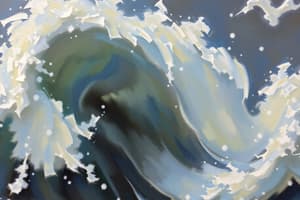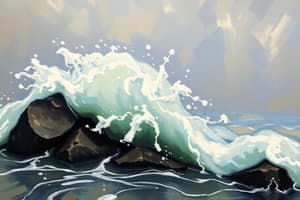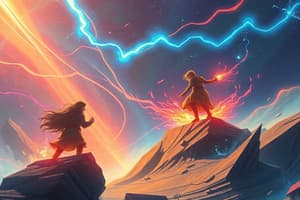Podcast
Questions and Answers
Which of these options describes a non-contact force?
Which of these options describes a non-contact force?
- Friction
- Applied force
- Gravitational force (correct)
- Tension
What is the unit used to express the magnitude of force?
What is the unit used to express the magnitude of force?
Newton
Uniform forces are forces that are unequal.
Uniform forces are forces that are unequal.
False (B)
Match the following types of forces with their definitions:
Match the following types of forces with their definitions:
Friction is a non-contact force.
Friction is a non-contact force.
The symbol for tension is ______.
The symbol for tension is ______.
What is the purpose of air resistance?
What is the purpose of air resistance?
Flashcards are hidden until you start studying
Study Notes
Types of Forces
- Uniform Forces: Forces that are equal and balanced, resulting in no change in motion.
- Non-uniform Forces: Forces resulting in unequal displacements, leading to acceleration or deceleration of objects.
- Contact Forces: Occur when objects are physically touching each other.
- Applied Forces: Forces exerted when two objects come into contact.
- Non-contact Forces: Forces that act at a distance without physical contact, such as gravitational or magnetic forces.
Characteristics of Force
- Motion: Forces can initiate movement, stop motion, change direction, push, pull, or alter the speed of objects, including those at rest.
- Tension Force: A pulling force transmitted through strings, ropes, or cables.
- Symbol for Tension: Represented by the letter T.
- Balanced forces: When two opposing forces are equal, the net force is zero, leading to balanced scenarios.
- Magnitude: Refers to the size or strength of a force.
- Measurement: Magnitude is expressed in Newtons (N).
- Direction: Indicates the path an object will take under the influence of a force.
- Arrow Representation: The length of an arrow in force diagrams indicates the amount of force; longer arrows represent stronger forces.
Examples of Forces
- Friction: A force that opposes motion, slowing down objects moving relative to one another.
- Symbol for Friction: Denoted by Fr.
- Air Resistance: A type of frictional force that acts against the motion of objects moving through the air.
Studying That Suits You
Use AI to generate personalized quizzes and flashcards to suit your learning preferences.




